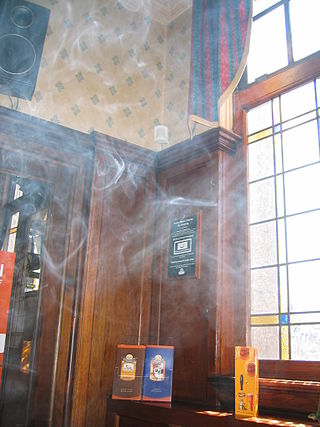
In organic chemistry, isocyanate is the functional group with the formula R−N=C=O. Organic compounds that contain an isocyanate group are referred to as isocyanates. An organic compound with two isocyanate groups is known as a diisocyanate. Diisocyanates are manufactured for the production of polyurethanes, a class of polymers.
The Occupational Safety and Health Administration is a regulatory agency of the United States Department of Labor that originally had federal visitorial powers to inspect and examine workplaces. The United States Congress established the agency under the Occupational Safety and Health Act, which President Richard M. Nixon signed into law on December 29, 1970. OSHA's mission is to "assure safe and healthy working conditions for working men and women by setting and enforcing standards and by providing training, outreach, education, and assistance." The agency is also charged with enforcing a variety of whistleblower statutes and regulations. OSHA's workplace safety inspections have been shown to reduce injury rates and injury costs without adverse effects on employment, sales, credit ratings, or firm survival.

Passive smoking is the inhalation of tobacco smoke, called passive smoke, secondhand smoke (SHS) or environmental tobacco smoke (ETS), by individuals other than the active smoker. It occurs when tobacco smoke diffuses into the surrounding atmosphere as an aerosol pollutant, which leads to its inhalation by nearby bystanders within the same environment. Exposure to secondhand tobacco smoke causes many of the same diseases caused by active smoking, although to a lower prevalence due to the reduced concentration of smoke that enters the airway.

The Toxic Substances Control Act (TSCA) is a United States law, passed by the 94th United States Congress in 1976 and administered by the United States Environmental Protection Agency (EPA), that regulates chemicals not regulated by other U.S. federal statutes, including chemicals already in commerce and the introduction of new chemicals. When the TSCA was put into place, all existing chemicals were considered to be safe for use and subsequently grandfathered in. Its three main objectives are to assess and regulate new commercial chemicals before they enter the market, to regulate chemicals already existing in 1976 that posed an "unreasonable risk of injury to health or the environment", as for example PCBs, lead, mercury and radon, and to regulate these chemicals' distribution and use.
Steven J. Milloy is a lawyer, lobbyist, author and former Fox News commentator. Milloy is the founder and editor of the blog junkscience.com.

Hexavalent chromium (chromium(VI), Cr(VI), chromium 6) is chromium in any chemical compound that contains the element in the +6 oxidation state (thus hexavalent). The hexavalent form rarely occurs naturally.
Jim Tozzi is an American lobbyist, currently the head of the Center for Regulatory Effectiveness, an industry-supported, for-profit lobbying organization that describes itself as a "regulatory watchdog." Formerly, he was a regulatory official of the United States Office of Management and Budget (OMB). His partner for many years was Thorne G. Auchter and they ran two main lobbying organisations, Federal Focus and Multinational Business Services.
The Advancement of Sound Science Center (TASSC), formerly The Advancement of Sound Science Coalition, was an industry-funded lobby group and crisis management vehicle, and was created in 1993 by Phillip Morris and APCO in response to a 1992 United States Environmental Protection Agency (EPA) report which identified secondhand smoke as a "confirmed" human carcinogen. TASSC's stated objectives were to (1) discredit the EPA report; (2) fight anti-smoking legislation; and (3) pro-actively pass legislation favourable to the tobacco industry.
Right to know is a human right enshrined in law in several countries. UNESCO defines it as the right for people to "participate in an informed way in decisions that affect them, while also holding governments and others accountable". It pursues universal access to information as essential foundation of inclusive knowledge societies. It is often defined in the context of the right for people to know about their potential exposure to environmental conditions or substances that may cause illness or injury, but it can also refer more generally to freedom of information or informed consent.
Gio Batta Gori is an epidemiologist and fellow with the Health Policy Center in Bethesda, Maryland which he established in 1997 and where he specializes in risk assessment and scientific research. He was deputy director of the United States' National Cancer Institute's Division of Cancer Cause and Prevention, where he directed the Smoking and Health Program and the Diet and Cancer Program.

The Food Quality Protection Act (FQPA), or H.R.1627, was passed unanimously by Congress in 1996 and was signed into law by President Bill Clinton on August 3, 1996. The FQPA standardized the way the Environmental Protection Agency (EPA) would manage the use of pesticides and amended the Federal Insecticide, Fungicide, and Rodenticide Act and the Federal Food Drug and Cosmetic Act. It mandated a health-based standard for pesticides used in foods, provided special protections for babies and infants, streamlined the approval of safe pesticides, established incentives for the creation of safer pesticides, and required that pesticide registrations remain current.
The Weinberg Group is a Washington, DC-based food and drug regulatory consulting group. Founded in 1983, the firm assists pharmaceutical and biotech companies with the "development and implementation of successful and innovative regulatory strategies" and also helps these companies to "remediate, maintain and improve their regulatory compliance." The Weinberg Group sent a memo to DuPont in 2003 recommending that the company “reshape the debate by identifying the likely known health benefits of PFOA exposure.”

The Office of Environmental Health Hazard Assessment, commonly referred to as OEHHA, is a specialized department within the cabinet-level California Environmental Protection Agency (CalEPA) with responsibility for evaluating health risks from environmental chemical contaminants.
Regulatory science is the scientific and technical foundations upon which regulations are based in various industries – particularly those involving health or safety. Regulatory bodies employing such principles in the United States include, for example, the FDA for food and medical products, the EPA for the environment, and the OSHA for work safety.

Pesticide regulation in the United States is primarily a responsibility of the Environmental Protection Agency (EPA). In America, it was not till the 1950s that pesticides were regulated in terms of their safety. The Pesticides Control Amendment (PCA) of 1954 was the first time Congress passed guidance regarding the establishment of safe limits for pesticide residues on food. It authorized the Food and Drug Administration (FDA) to ban pesticides they determined to be unsafe if they were sprayed directly on food. The Food Additives Amendment, which included the Delaney Clause, prohibited the pesticide residues from any carcinogenic pesticides in processed food. In 1959, pesticides were required to be registered.

The Integrated Risk Information System (IRIS) is an environmental assessment program operated by the U.S. Environmental Protection Agency (EPA). The IRIS program is focused on risk assessment, and not risk management.
Good Epidemiological Practices or Good Epidemiology Practices (GEP) was a set of guidelines produced by the U.S. Chemical Manufacturers Association (CMA) in 1991 to improve epidemiologic research practices. It was then adopted by the tobacco industry around 1993 as part of its "sound science" program to counter criticisms of the industry on health and environmental issues such as secondhand smoke. It failed to make much impact on the US and European regulators, but may have had more influence in its later manifestations in Asia and particularly China.
Thorne Auchter is the former Director of the U.S. Occupational Safety & Health Administration (OSHA) from 1981 to 1984, during the early part of the Reagan Administration, replacing former President Jimmy Carter's appointee Eula Bingham. He is also the former director of the American lobbying group Federal Focus' Institute for Regulatory Policy.
There are unique occupational health issues in the casino industry, many of which are attributed to repetitive tasks and long-term exposures to hazards in the casino environment. Among these issues are cancers resulting from exposure to second-hand tobacco smoke, musculoskeletal injury (MSI) from repetitive motion injuries while running table games over many hours, and health issues associated with shift work. Safety and regulatory agencies in the United States have implemented regulatory measures to address the specific risks associated with workers in the casino industry, and have made efforts to identify additional possible risks to casino workers, including noise-induced hearing loss and heavy metal poisoning from exposure to dust from coins.
ChemRisk is a Delaware Limited Liability Company, a for-profit scientific consulting firm headquartered in San Francisco, California that is part of Cardno ChemRisk. ChemRisk founder and former president, Dennis Paustenbach, "has long been an expert witness and top consultant" to "scores of companies in the chemical, energy and medical products industries" facing lawsuits over products or environmental practices or product safety. Their clients included San Francisco-based utility Pacific Gas & Electric (PG&E) and BP. ChemRisk uses toxicology and risk assessment to measure the hazards of chemicals in soil, air, water, food, sediments and consumer products.






